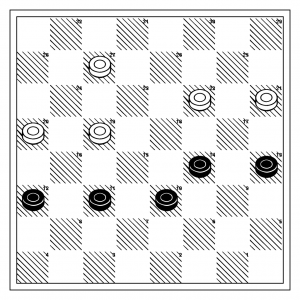Fifth Position, a test for milhouse
My trip to Powell’s also netted me Erroll A. Smith’s The American Checker Player’s Handbook, a nice little tome published in 1944. It mostly is an introduction to the famous two-move openings, systematically organizing the forty-seven two-move openings into 7 so-called “Master” openings, and then the Major Variations. There are two principle areas that I’d like to see Milhouse, one is the openings, so I think it might be useful once I get going on that project. But in the mean time, it also has some nice positions that are good tests for either its general play, or its play with the endgame database. Witness the so-called Fifth Position:
Without an endgame database, it takes milhouse a 21 ply search to find the right variation that avoids a loss for white.
+1 : [-5] 0.00s
: 27-24
+3 : [3] 0.00s
: 27-24 11-15 20-16
... researching after failing low (-122)
+5 : [-124] 0.00s
: 27-24 11-15 20-16 14-18 21-17
... researching after failing high (-9)
+7 : [-9] 0.00s
: 20-16 11x20 27-23 12-16 19x12 20-24 12-8
... researching after failing low (-34)
+9 : [-37] 0.00s
: 20-16 11x20 27-23 20-24 22-18 24-27 18x9 27-32 23-18
+11 : [-35] 0.01s
: 20-16 11x20 27-23 20-24 22-18 24-27 18x9 27-32 23-18
: 10-14 18-15
+13 : [-40] 0.02s
: 20-16 11x20 27-23 20-24 22-18 24-27 18x9 10-14 19-15
: 27-32 23-19 32-27 15-10
... researching after failing low (-78)
+15 : [-116] 0.08s
: 20-16 11x20 27-23 20-24 22-18 24-27 18x9 10-14 19-15
: 12-16 9-6 27-32 6-1 32-27 23-18
+17 : [-119] 0.23s
: 20-16 11x20 27-23 20-24 22-18 24-27 18x9 10-14 9-6
: 27-32 19-15 12-16 23-18 14x23 6-1 32-27 1-5
+19 : [-114] 0.72s
: 27-23 11-15 20-16 15x24 16-11 10-15 23-19 14-18 19x10
: 18x25 11-8 24-27 10-6 27-32 6-1 25-30
... researching after failing high (-89)
+21 : [-11] 2.65s
: 20-16 11x20 27-23 20-24 22-18 13-17 18x9 10-14 9-6
: 24-27 6-1 27-31 1-5 31-27 5-9 27x18 19-15 18x11
: 9x18
+23 : [-16] 5.54s
: 20-16 11x20 27-23 20-24 22-18 24-27 18x9 27-32 23-18
: 10-14 18-15 13-17 9-6 17-22 6-1 22-26 15-10
+25 : [-17] 13.83s
: 20-16 11x20 27-23 20-24 22-18 24-27 18x9 27-32 23-18
: 10-14 18-15 13-17 9-6 32-27 6-1 17-22 15-10
The play listed in this line differs a bit after the capture 18×9, but the Cake endgame database lists the move as drawn after that capture, and it appears that milhouse is able to hold a drawing line. Smith lists 27-31 as a drawing variation, but suggests 10-14 as the drawing move. Using the Cake database, it also appears that 12-16 and 27-32 can draw as well.
Using the endgame database, milhouse asserts that the game is drawn with a 7 ply search, after searching less that 1000 nodes, about a 450 fold increase in speed.

I recall burning three or four weeks of a sabbatical getting Saccade.com on the air with Wordpress. So much tweaking…